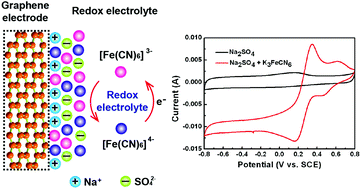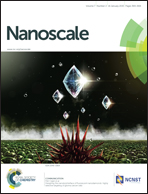Carbon with ultrahigh capacitance when graphene paper meets K3Fe(CN)6†
Abstract
For the first time, we have shown a novel supercapacitor system with a graphene paper electrode in the redox-electrolyte of K3Fe(CN)6 based on the system-level design principle. By combining electric double-layer capacitance and pseudocapacitance, the specific capacitance could be increased 5-fold compared with the conventional electrode–electrolyte system. This large improvement is attributed to the additional redox reactions on the graphene paper electrode via the constituent ions of K3Fe(CN)6 in the redox-electrolyte, during which the discharge process is highly enhanced. More importantly, the potential interval could reach as high as 1.6 V beyond the limited operating voltage of water (∼1.23 V). After 5000 continuous cycles, 94% of the initial capacitance was retained. The newly designed novel supercapacitor system is binder-free, conducting additive-free and can deliver higher capacitance. This designed graphene-paper-electrode/redox-electrolyte system can provide a versatile strategy for high-capacitance supercapacitor systems.


 Please wait while we load your content...
Please wait while we load your content...